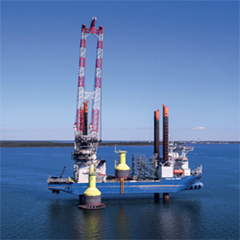PES brings you Jan De Nul’s experience of constructing the Tahkoluoto wind farm. The geographical location, the elements and the difficult terrain all posed different types of challenges. Previous knowledge gained on other ventures, suitable equipment and engineering skills were crucial to the success of this project.
Possible ice and rocky soil: these were the conditions in which Jan De Nul Group installed the very first Finnish Offshore Wind Farm, Tahkoluoto. It is named after the port nearby, meaning ‘islet of the grindstones.’
In fact it was hard diabase bedrock below the seabed and a layer of moraine clay and boulders of different sizes on top of it. Being the remains of scraping glaciers in previous glaciation periods, it was a challenging environment in which to construct a wind farm, able to withstand the severe Finnish winters.
None of the classical monopile driving methods, such as the one Jan De Nul Group used to construct the Belgian offshore wind farm Nobelwind, could be used here, in the Gulf of Bothnia, because of the soil conditions. An atypical design and construction of the wind turbine foundations was necessary.
The only option was to place ballasted foundations on a prepared seabed. This was certainly no practice run for Jan De Nul Group. The Group had already designed, constructed and installed sixteen gravity based foundations for Karehamn, the Swedish wind farm. The foundations had specific dimensions ranging from 15 to 25 metres. The heaviest of them had a weight of 1,940 tonnes. The Jan De Nul Group was able to use the know-how gained from this prior experience on this project.




























